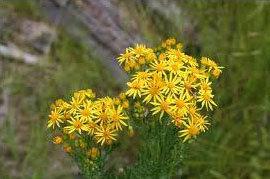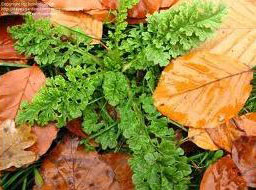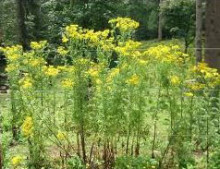— from Kate Yturri, Judy Winer and Gwen Stamm, Master Gardeners —
 Tansy ragwort is a winter annual, biennial, or short-lived perennial that can grow up to 6 feet tall. It is easily recognized by its bright yellow flower heads, with each flower bearing about 13 petals (ray florets), and by its soft, deeply lobed leaves. It is easy to spot when it is in bloom around this time of year.
Tansy ragwort is a winter annual, biennial, or short-lived perennial that can grow up to 6 feet tall. It is easily recognized by its bright yellow flower heads, with each flower bearing about 13 petals (ray florets), and by its soft, deeply lobed leaves. It is easy to spot when it is in bloom around this time of year.
 You can also see smaller plants setting up for next year’s bloom as seen in the photo to the right.
You can also see smaller plants setting up for next year’s bloom as seen in the photo to the right.
Tansy is toxic to horses and cattle whether fresh or dry, causing irreversible liver damage. It spreads aggressively and seeds prolifically with seeds remaining viable in the soil for 10 years. Also, bees collect the pollen from tansy flowers. The honey that is made from these flowers can have an off taste. Milk collected from tansy-browsing-cows can also have an off taste.
Control:
Be sure to wear protective gloves and consider a face mask if you are sensitive to tansy ragwort’s allergens
Small patches or isolated plants can be hand-pulled or dug with a shovel. Before bloom they can be discarded in the trash or left on the ground to decompose. However, if plant is in bloom, the flowers and seed heads need to be bagged and taken to the solid waste facility for no charge.
Mowing is not recommended as plants will just reflower at a height shorter than the mower blade. In addition, cut plants will re-sprout in the following season with even more vigorous and multiple stalks.
For large infestations, selective herbicides can be effective. Contact the County Noxious Weed Program for specific herbicide information. Phone number: 376-3499.









Is Tansy ragwort same plant as Scotch Broom?
No they are different noxious weeds. There was an article about Scotch Broom in Orcas Issues last week.